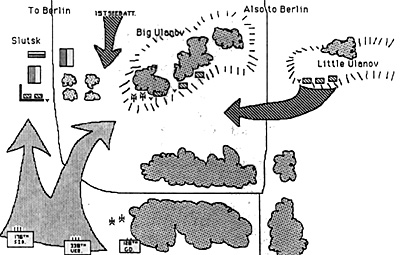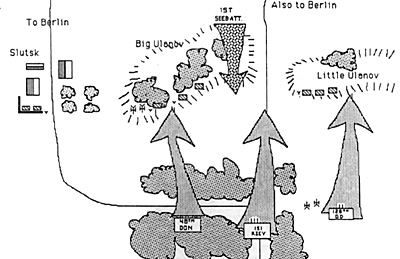Although both the colonial period and the WWII period have been popular with wargamers, the battles of the First World War have been long neglected. Much of the neglect is probably due to the overall impression of a bloody stalemate in the trenches fought by drab armies without glory or panache. Perhaps wargamers are beginning to realize that this gross generalization hides much of the truth, because the WWI period is experiencing a growth in popularity. Several manufacturers have released lines of WWI figures and equipment, new rules are appearing, and games such as Conrad Wiser's TRENCHFIGHT are being played at conventions. Recently, two PW members, Fred Haub and Terry Sirk, have authored an exhaustive set of rules called GREAT WAR , which has been played several times at our Potomac Wargamers meetings.
At a recent PW meeting, Fred set up an Eastern Front battle to test a scenario for the HMGS Mini-Con. We played two battles of the same scenario. I offer it here for the reader's enjoyment. The place names were invented and the game names of the participants were bestowed by the author --- none have any basis in fact (except perhaps for Ed "von Death" Hyland, who seemed to take particular relish in hammering my hard-working Russians!).
The scenario was basic: A reinforced German regiment had orders to hold the Slutsk-Ulanov Ridge line to block a thrust by two Russian regiments supported by artillery and a Guard battalion. Order of battle was:
Germans (commanded jointly by Bill "Killer Kaiser" Rankin and Ed "von Death" Hyland)
- 36th Brandenburgers Rifle Regt
109th Field Artillery Battery (2 guns)
1st SeeBattalion (Reinforcements on Turn 2)
Russians
- 176th Siberian Rifle Regt (Mike "Little Kutusov" Pierce)
338th Ukranian Militia Regt(Mark "Peasant General" Storch)
Simonov Artillery (2 guns) (Sam "The Bolshevik" Hepford)
68th Guard Inf Battalion (Chris "Borodino" Hylind)
 The First Battle of Ulanov
The First Battle of Ulanov
The Russian staff disdained any complicated maneuvers. The Siberians were ordered to march straight for the village of Slutsk. The Ukranians would advance alongside, then swing right into the woods on Big Ulanov. The guns of the Simonov artillery were to pound their German counterparts into silence, and the Guard would hold themselves in readiness to exploit the breakthrough (what else!). Map 1 shows the initial German set-up and planned offensive.
The guts of GREAT WAR is the Incremental card move/fire system. Very briefly, each side has a deck of Increment cards, eight in all, numbered from 1 to 3. One card is drawn at the beginning of each player-turn: the number of Increments indicated is the number of times each unit can move and/or fire in that turn. For example, if the German player draws a 2-Increment card, German units could move for 2 Increments, or fire for 2 Increments, or move 1 Increment and fire 1 Increment. Fred and Terry have rated each nationality of WWI to reflect their leadership, initiative, and discipline. In our game, the Germans had three 3- increment cards, four 2-Increment cards, and only one 1-Increment card, while the Russians had only 1 3-Increment card, three 2-Increment cards, and 4 1- Increment cards. This difference in total number of Increments available had a profound effect on tactics and play. Since none of the Russian players had any experience with GREAT WAR rules, we didn't find out just how profound until too late.
The assault started in fine style. The Russians drew a 2-Increment card, let loose a resounding "URRA!", and rushed forward. The Germans drew a 1-Increment card. Their artillery fired at the Siberians but inflicted little loss. The artillery mechanism is unusual. The firing player picks the center of the target area, then the player fired on aligns a 3 "x 5" grid over the target center to get the fewest figures in the target area. It works. The rest of the German troops awaited the Russians.
On turn 2, the Russian advance slowed to a crawl with a 1-Increment card. The Simonov artillery fired on the German guns with no effect. With a 3- increment card, German counterbattery fire at the Simonov artillery killed several crewman outright. In GREAT WAR, each company that takes casualties must roll morale immediately. A unit that passes its morale check must also check to see if it is pinned down by the fire. The remaining Simonov artillery crewmen discovered the better part of valor and abandoned their guns. The German battalion on Little Ulanov Hill began to move towards the Russian right flank.
The Russians again drew only a 1 Increment card and continued their relentless but slow advance. With a 2 Increment draw for the Germans, things began to look bleak for Mother Russia. The Siberians had moved within MG range from the Germans in Slutsk. In GREAT WAR, the number of casualties inflicted from MG and rifle fire depends on the number of figures firing, the increments of fire, and weapon value (which varies with range). The result of this calculation yields a percentage chance of hits. The percentage may be higher than 100%, in which case one casualty is automatic, and the remainder is a percentage chance of another hit. All weapons have pass through fire at half effect for each rank out to their range limit. Thus, a close- order formation can be decimated very quickly.
In the face of this long range MG fire, the Siberians took some casualties but held to their task. On the right flank, the Ukranians began to take casualties from German artillery and MGs in the woods on Big Ulanov.
A 2-Increment move for the Russians --- the Siberians pressed straight ahead while the Ukranians swung right to begin their push on Big Ulanov Hill. But the Germans were ready--with another 3Increment card. Gleeful Brandenburger machine gunners and riflemen opened up in the face of the Siberians while the German artillery shifted to also pound them. Five of eight Siberian companies and 1 MG section were hit and either pinned or failed morale and ran away.
But the dogged Russians pushed on drawing a 3-Increment card. Some Siberian companies regained their morale and returned fire as their fresh comrades rushed forward. For the first time the Germans began to take casualties. The Ukranians disdained fire and ran forward towards the Germans on Big Ulanov. However, German fire at close range with 2 Increments was devastating. By the end of turn 5, most of two Russian infantry regiments were either pinned under a storm of German fire or were running for the rear. The Russian Guards battalion was busy rounding up stragglers.
By mutual consent the slaughter was over. Two Russian regiments were decimated and an artillery battery was wrecked. Total German casualties amounted to one company killed, two artillery crew figures killed, and one MG crew killed. The road to Berlin was still blocked.
 The Second Battle of Ulanov
The Second Battle of Ulanov
After sending the remnants of the 176 Siberian and 338 Ukranian Regiments to the rear for rest and refit, the CZAR'S best generals pondered again how to quickly break the German block on the Ulanov Ridge line. This time, the Russians decided to use guile and cunning. Fresh forces, the 151 Kiev Militia and the 48th Don Rifles, again supported by the Simonov Artillery and the 68th Guards Battalion, were readied for the next big push. Map 2 shows the dispositions fur the 2nd Battle of Ulanov.
The Kiev Militia was ordered to push down the highway towards the defile between Big Ulanov and Little Ulanov Hills. On their right, the Simonov artillery were to soften up the German fieldworks on Little Ulanov, while the Guards Battalion stormed this position. Meanwhile, the Don Rifles would advance through the woods on the left, and, at.the right moment, attack to support the Kiev Militia.
The attack started well. It was obvious that the Germans were surprised by the Russian deployment. But again the Russian attack was slow to develop (low Increment card draws), while the Germans reacted swiftly to the new assault.
It took 3 turns for the Simonov artillery to unlimber and open up on the Germans, but results were negligible. The Kiev Militia emerged from the woods and began to deploy out of column while the Don Rifles moved slowly through the woods. An interesting feature of GREAT WAR rules came into play about this time, Each side starts with a number of Command Factors equal to the number of companies in the starting force. These Us are used to allow companies to move and fire. During the game, you gain Us by winning melee combats, and you lose them by losing melees and having companies rout. Costs to activate a company are doubled to move in woods or rough terrain. The net effect is that as a battle develops, players must make decisions on which companies to activate. The Russian attack began to slow as the 48th Don Rifles became bogged down in the woods.
The Germans moved the 1st SeeBattalion onto Big Ulanov Hill and shifted their artillery to fire on the 151 Kiev Militia. The Germans on Little Ulanov alternated their fire between the Guards and the boys from Kiev. Their fire was accurate and deadly.
The stodgy Russians kept coming despite the withering fire. A 2- Increment card gave them hope. The Don Rifles, hampered by poor command control, continued to crawl slowly through the woods. German fire continued in volume and deadliness.
With a 3-increment card, the Russian attack gained new life. The Don Rifle burst out of the woods and began to bring the German positions on Big Ulanov Hill under fire. The Guards Battalion regained their morale and rushed towards Little Ulanov, while the Simonov artillery finally started to have some effect on the Germans in their fieldworks. In the center, the implacable Kiev Militia moved forward, sensing a way to victory. German reaction was slow (1-Increment card) and their fire dropped off.
The attack had reached its climax. If the Russians could draw a good Increment card, they would be in the German positions, while a high German draw would see the Russians decimated. But once again, superior training, initiative, and good luck prevailed: the Russians drew a 1 Increment card while the Germans drew for 3Increments. The Russian attack collapsed under a pinpoint artillery barrage and murderous Maxim fire. With most of the Kiev Militia and the Don Rifles pinned or retreating, the Russians stopped the needless slaughter. The door to Berlin had been slammed shut!
The two battles, although both were pretty one-sided, were enjoyed by all players. We realized quickly the basic lessons of WWI (an attack across open ground unsupported by adequate artillery against entrenched troops is called SUICIDE!). GREAT WAR is quickly understood and easily played.
Until the rules are published, you'll have to come to the PWG meetings to find out if the German counterattack can crack the Russian line of entrenchments below the Ulanov Ridge!
Back to PW Review July 1987 Table of Contents
Back to PW Review List of Issues
Back to MagWeb Master Magazine List
© Copyright 1987 Wally Simon
This article appears in MagWeb (Magazine Web) on the Internet World Wide Web.
Other articles from military history and related magazines are available at http://www.magweb.com